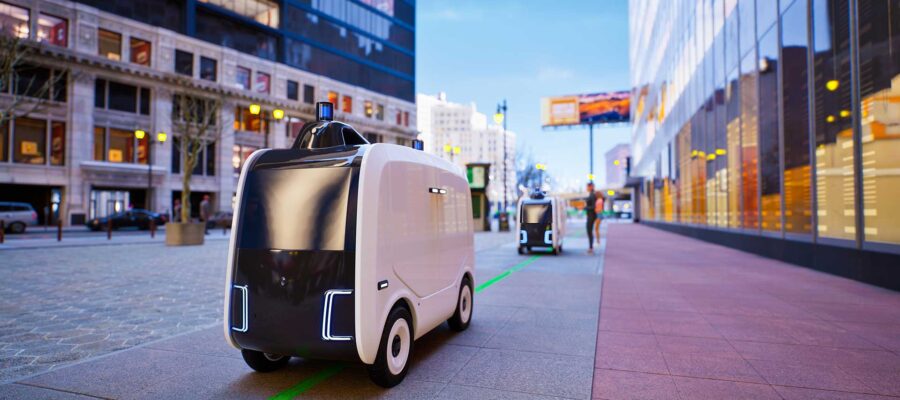This post has already been read 12696 times!
Much of the publicity around autonomous vehicles has centered on consumer applications and robo-taxis. While important, these are far from the only use cases of driverless technology. Last-mile deliveries can also benefit heavily from self-driving cars.
The e-commerce boom has led to a similar surge in last-mile routes — one that won’t likely fade anytime soon. Amid this trend, logistics companies must optimize these workflows wherever possible. In many cases, that means capitalizing on new technologies, and autonomous vehicles will become a particularly advantageous innovation as they become more widely available.
Easing Labor Shortages
Self-driving vehicles will have the most immediate impact on this sector by mitigating ongoing worker shortages. While automation typically raises fears of job displacement, that’s not as pressing a concern in this sector, as humans aren’t taking available jobs.
How Autonomous Vehicles Will Transform Last-Mile Delivery: #1 Ease the 3 million driver shortage… Share on XThere are over 3 million open driving positions in the world today. That gap will likely grow over time, as just 12% of the current driver workforce is below 25. Maintaining efficient delivery routes will become increasingly difficult as demand rises and more workers retire.
Automating last-mile deliveries with self-driving vehicles lets logistics providers accomplish more work despite a diminished workforce. These shorter routes are ideal applications for automation, as they’re more easily automatable than longer, more complex long-haul drives.
Improving Driving Efficiency
Similarly, autonomous vehicles will make last-mile delivery more efficient. Part of this productivity increase comes from their impact on the workforce. Human employees will be able to work more efficiently because they face reduced workloads as automation removes the need for some tasks.
Driverless vehicles will also improve efficiency by providing faster means of transportation. Autonomous last-mile delivery solutions include drones and robotic carts, not just road-faring trucks and vans. These smaller vehicles can avoid the traffic that causes 1.27 billion hours of delay each year.
Sending products through drones or autonomous carts leaves more trucks and vans available for other deliveries. All these factors combine to create a future of more deliveries completed in less time. In addition to helping businesses boost productivity, that speed will increase customer satisfaction, as people won’t wait as long for their ordered goods.
Reducing Costs
The shift to autonomous last-mile deliveries will also lead to lower operating costs. Many of these savings stem from the added efficiency that automation enables. More deliveries in less time translates into lower relative costs per delivery.
How Autonomous Vehicles Will Transform Last-Mile Delivery: Lower expenses on freight rates… Share on XAutonomous deliveries incur fewer expenses than conventional alternatives. Freight rates keep rising — they jumped 23% in 2021 alone — but drones and similar technologies let businesses handle the last mile themselves. Consequently, their cubic footprints for truck deliveries shrink, leading to lower third-party freight spending.
Avoiding traffic by traveling through the air or on sidewalks has monetary benefits. The 1.27 billion hours trucks spend waiting in traffic leads to 6.8 billion gallons of wasted fuel. Consequently, fleets can save a considerable amount on ongoing vehicle costs by handling last-mile deliveries through autonomous methods that avoid traffic.
Minimizing Emissions
On a related note, autonomous last-mile delivery reduces greenhouse gas emissions. Transportation accounts for 29% of all U.S. emissions — the most of any sector — and 58% come from light-duty vehicles. Consequently, last-mile deliveries may have a larger impact on the environment than long-haul trucking, where the heavy-duty vehicles involved emit less. While automation doesn’t necessarily eliminate these emissions on its own, it can reduce them in several ways.
Drones and autonomous delivery carts are typically electric, so they emit no hazardous fumes. Even if a self-driving car uses fossil fuels, the increased efficiency from AI-guided routing and reduced weight will lead to fewer emissions.
Reducing Theft
Automating last-mile deliveries will also reduce theft-related concerns. Package theft has become a serious issue as e-commerce has grown — thieves stole more than $8 billion in merchandise in 2023 alone. While “porch pirates” are the most prominent source of this theft, much occurs before delivery.
How Autonomous Vehicles Will Transform Last-Mile Delivery: Reduce the $8B of merchandise stolen annually… Share on XPackages pass through many hands before they reach their final destination, each presenting a possible point for theft to occur. Automating last-mile deliveries lets logistics companies reduce these touch points. Robots won’t steal packages, so customers can be sure their deliveries will arrive safely.
Autonomous delivery vehicles also produce real-time location data by design. They wouldn’t be able to navigate without it. Businesses can pass this information on to customers to offer more assurance and inform their schedules to reduce porch piracy.
Last-Mile Delivery Automation Will Benefit Everyone
While autonomous delivery isn’t a viable reality yet, it won’t be long before it becomes one. It will happen before self-driving cars populate roads, and businesses should capitalize on that opportunity.
Autonomous last-mile delivery is faster, more efficient, safer, more cost-effective and addresses labor challenges. That’s far too much potential to ignore. This technology will reshape logistics as more organizations act on that promise.

Recommended Posts
- Are Micro Fulfillment Centers the Next Frontier in Retail Logistics?
- Rethinking Defense Supply Chains with Network-Based Command Centers
- How to Use Predictive Analytics to Streamline Cross-Border Logistics
- AI Plus Humans for Resilient Freight Forwarding in a Complex World
- Modern Defense Supply Chains: The Essential Capabilities for Multi-Domain Operations
- How to Use Predictive Analytics to Streamline Cross-Border Logistics - May 19, 2025
- The Role of Robotics in Advanced Packaging Systems - December 4, 2024
- Ensuring Supply Chain Resilience Through Enhanced Visibility - September 24, 2024
